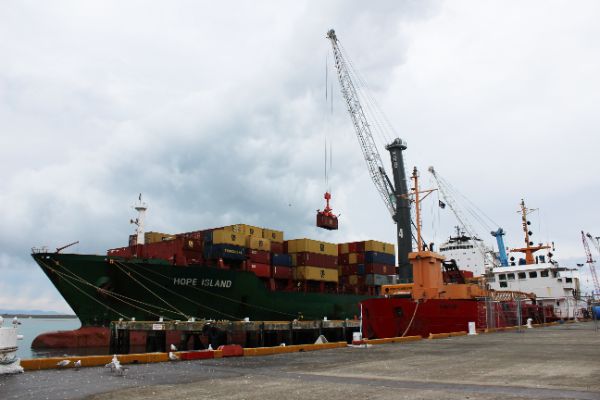Port Nelson Reduces Its Fuel And Carbon Emissions By Investing In A New Crane To Improve Efficiencies

Port Nelson continues to improve efficiencies with the purchase of a new Liebherr Crane, an investment of nearly $9 million. This is part of a multi-million-dollar programme of works to enable Port Nelson to meet the trend towards larger vessels. The new crane will provide safer and more efficient container operations and will replace the Port’s crane “No 2”.
The new crane comes with impressive statistics; 85m in height, with a reach of 58m and the capability to safely lift 140 tonnes on hook and 65 tonnes on spreader. This is compared to crane “No 2” which stands at only 70m, has a reach of 48m, and lifts 102 tonnes on hook and 52 tonnes on spreader. To operate within the 85m height range, approval was required from the Civil Aviation Authority due to the proximity to the flight path for Nelson Airport. Lights will also be required to be visible to aircraft. The cab on the new machine is 4.8m higher than what is currently used. This is to ensure visibility for crane drivers as the trend towards stacking continuers higher on vessels continues to increase.
The crane assembly took approximately 4 weeks. Jonny Cook, Container Operations Manager comments on the assembly process, ‘Liebherr Engineers were flown in from Germany due to the new crane being the first of its size in New Zealand for Liebherr. This ensured that the crane assembly was both quality checked and retains warranty. The crane came in 3 main components, each component had an engineered process to lift and connect each piece into place, followed by a connection of mechanical, hydraulic and electrical componentry. Critical to the successful assembly was the involvement of the Port Workshop’s two crane mechanics and the electrical team.’
Familiarisation of the crane is expected to take around 2 weeks which consists of the Port’s crane operators training with the in-house crane simulator set up for Liebherr cranes. The crane is likely to be brought into full service early in the New Year.
Environmental factors were a key criteria in the decision over which crane to purchase, as Port Nelson works toward its target of being carbon zero by 2050.
‘The new crane will reduce the Port’s fuel and carbon emissions. The increased lifting capability from one 20-foot container to two will significantly reduce the amount of crane movements at the Port.’ says Hugh Morrison, CEO of Port Nelson. ‘The crane also has double the expected life span compared to our other cranes, further reducing our environmental impact by reducing waste.’ The crane also has the ability to be retrofitted with an electrical engine. This allows for a conversion once the technology has been adequately proved internationally and access to alternative power generation sources have been developed.
The Port is also committed to being a good neighbour which includes managing the Port’s noise. Identified noise reduction initiatives with the new crane includes a better insulated engine room and cameras for operation, and a sensor system for soft landing containers, an initiative the Port is currently testing.
The Port investing in its infrastructure will allow the Port to continue to be the region’s gateway to the world ensuring goods reach their export market optimally and efficiently.


 PSA: PPPs Pose Risks To New Zealand Workers
PSA: PPPs Pose Risks To New Zealand Workers Office of the Privacy Commissioner: New Research Shows Business Leaders Fear Being On The Hook For Others’ Privacy Breaches
Office of the Privacy Commissioner: New Research Shows Business Leaders Fear Being On The Hook For Others’ Privacy Breaches E Tū: E Tū Members Send Open Letter To James Grenon And NZME Board
E Tū: E Tū Members Send Open Letter To James Grenon And NZME Board Commerce Commission: Commission Calls For Comments On Copper Access Deregulation
Commerce Commission: Commission Calls For Comments On Copper Access Deregulation New Zealand Association of Scientists: NZAS Supports Saving Biotechnology Capacity In Callaghan; Asks What Now For Applied Technology Group
New Zealand Association of Scientists: NZAS Supports Saving Biotechnology Capacity In Callaghan; Asks What Now For Applied Technology Group Stats NZ: Business Employment Data - December 2024 Quarter
Stats NZ: Business Employment Data - December 2024 Quarter



